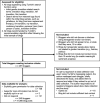Mapping gender transition sentiment patterns via social media data: toward decreasing transgender mental health disparities
- PMID: 31120498
- PMCID: PMC6696505
- DOI: 10.1093/jamia/ocz056
Mapping gender transition sentiment patterns via social media data: toward decreasing transgender mental health disparities
Abstract
Objective: Transgender people face substantial mental health disparities, and this population's emotional well-being can be particularly volatile during gender transition. Understanding gender transition sentiment patterns can positively impact transgender people by enabling them to anticipate, and put support in place for, particularly difficult time periods. Yet, tracking sentiment over time throughout gender transition is challenging using traditional research methods. This study's objective was to use social media data to understand average gender transition sentiment patterns.
Materials and methods: Computational sentiment analysis and statistics were used to analyze 41 066 posts from 240 Tumblr transition blogs (online spaces where transgender people document gender transitions) to understand sentiment patterns over time and quantify relationships between transgender identity disclosures, sentiment, and social support.
Results: Findings suggest that sentiment increases over time on average throughout gender transition, particularly when people receive supportive responses to transgender identity disclosures. However, after disclosures to family members, people experienced temporary increased negative sentiment, followed by increased positive sentiment in the long term. After transgender identity disclosures on Facebook, an important means of mass disclosure, those with supportive networks experienced increased positive sentiment.
Conclusions: With foreknowledge of sentiment patterns likely to occur during gender transition, transgender people and their mental healthcare professionals can prepare with proper support in place throughout the gender transition process. Social media are a novel data source for understanding transgender people's sentiment patterns, which can help reduce mental health disparities for this marginalized population during a particularly difficult time.
Keywords: health status disparities; mental health; minority health; social media; transgender persons.
© The Author(s) 2019. Published by Oxford University Press on behalf of the American Medical Informatics Association.
Figures
Similar articles
-
Coming Out to Doctors, Coming Out to "Everyone": Understanding the Average Sequence of Transgender Identity Disclosures Using Social Media Data.Transgend Health. 2020 Sep 2;5(3):158-165. doi: 10.1089/trgh.2019.0045. eCollection 2020. Transgend Health. 2020. PMID: 32923666 Free PMC article.
-
Decoding Digital Discourse Through Multimodal Text and Image Machine Learning Models to Classify Sentiment and Detect Hate Speech in Race- and Lesbian, Gay, Bisexual, Transgender, Queer, Intersex, and Asexual Community-Related Posts on Social Media: Quantitative Study.J Med Internet Res. 2025 May 12;27:e72822. doi: 10.2196/72822. J Med Internet Res. 2025. PMID: 40354116 Free PMC article.
-
The Gender Minority Youth Study: Overview of Methods and Social Media Recruitment of a Nationwide Sample of U.S. Cisgender and Transgender Adolescents.Arch Sex Behav. 2020 Oct;49(7):2601-2610. doi: 10.1007/s10508-020-01695-x. Epub 2020 Apr 18. Arch Sex Behav. 2020. PMID: 32306108 Free PMC article. Review.
-
Adult development and quality of life of transgender and gender nonconforming people.Curr Opin Endocrinol Diabetes Obes. 2016 Apr;23(2):188-97. doi: 10.1097/MED.0000000000000232. Curr Opin Endocrinol Diabetes Obes. 2016. PMID: 26835800 Free PMC article. Review.
-
Self-Reported Changes in Attractions and Social Determinants of Mental Health in Transgender Adults.Arch Sex Behav. 2017 Jul;46(5):1425-1439. doi: 10.1007/s10508-016-0812-5. Epub 2016 Aug 19. Arch Sex Behav. 2017. PMID: 27542082 Free PMC article.
Cited by
-
Emotional and cognitive changes surrounding online depression identity claims.PLoS One. 2022 Dec 1;17(12):e0278179. doi: 10.1371/journal.pone.0278179. eCollection 2022. PLoS One. 2022. PMID: 36454809 Free PMC article.
-
Associations Between Psychosocial Measures and Digital Media Use Among Transgender Youth: Cross-sectional Study.JMIR Pediatr Parent. 2021 Aug 13;4(3):e25801. doi: 10.2196/25801. JMIR Pediatr Parent. 2021. PMID: 34398792 Free PMC article.
-
Human-Computer Interaction, Ethics, and Biomedical Informatics.Yearb Med Inform. 2020 Aug;29(1):93-98. doi: 10.1055/s-0040-1701990. Epub 2020 Aug 21. Yearb Med Inform. 2020. PMID: 32823302 Free PMC article. Review.
-
Health informatics and health equity: improving our reach and impact.J Am Med Inform Assoc. 2019 Aug 1;26(8-9):689-695. doi: 10.1093/jamia/ocz132. J Am Med Inform Assoc. 2019. PMID: 31411692 Free PMC article.
-
Network Structure and Community Evolution Online: Behavioral and Emotional Changes in Response to COVID-19.Front Public Health. 2022 Jan 11;9:813234. doi: 10.3389/fpubh.2021.813234. eCollection 2021. Front Public Health. 2022. PMID: 35087790 Free PMC article.
References
-
- Stryker S. Transgender History. Berkeley, CA: Seal Press; 2009.
-
- James SE, Herman JL, Rankin S, et al. The Report of the 2015 U.S. Transgender Survey. Washington, DC: National Center for Transgender Equality; 2016. http://www.transequality.org/sites/default/files/docs/USTS-Full-Report-F.... Accessed December 8, 2016.
-
- Clements-Nolle K, Marx R, Katz M.. Attempted suicide among transgender persons. J Homosex 2006; 51 (3): 53–69. - PubMed
-
- Hendricks ML, Testa RJ.. A conceptual framework for clinical work with transgender and gender nonconforming clients: an adaptation of the Minority Stress Model. Prof Psychol Res Pract 2012; 43 (5): 460–7.




